
Concrete tips for using AI in the tourism sector
Artificial Intelligence (AI) is rapidly transforming how we work, consume and learn. This results in opportunities for tourism organisations for optimising operation workflows and improving their marketing and customer experience. This document provides practical tips on using AI in your tourism organisation now. We developed these tips tailored to tourism SMEs like tour operators, experience providers, destination managers and other stakeholders, including those with smaller budgets. Before you start working with AI, inform yourself about the impact of AI on the tourism industry and the concerns and risks described in the ‘How to prepare your tourism organisation for AI’ factsheet.
Contents of this page
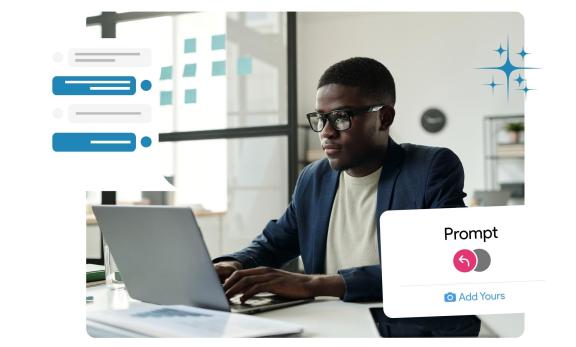
In this document, we created a section on how to help you grow your business with AI, focusing on B2B and B2C sales processes, how to use AI in market research, and how to use AI to make your business more sustainable.
The document presents several example prompts with the fictitious tour operator StorySafari. You can try them for free, but please note that they must be adjusted to your situation. Experiment and practice with them for the best results. The prompts explain the process; you will always need to copy and modify the prompt and ask the AI to adjust it to your situation.
CBI can not be held responsible for any content and mistakes the prompts make.
The document assumes you have a basic understanding of prompting, which you can learn with the help of the following video, which shows the basics of working with ChatGPT.
Video 1: First Steps in Chat GPT
Example

The Role, Task, Format, Context, Goal (RTFCG) framework for better prompting we learned during CBI’s AI content creation masterclass was quite beneficial for me, so I shared what I had learned with Saurav Lamichhane the B2B Sales Expert of CHN about the AI lessons with my teammates in an AI workshop.
To get the best results from AI we use our marketing strategy and database documents as context for the AI assistant.
Rubik Joshi, Marketing Lead - CHN Nepal
Figure 1: The Community Homestay Network (CHN) from Nepal is training its team to use AI effectively
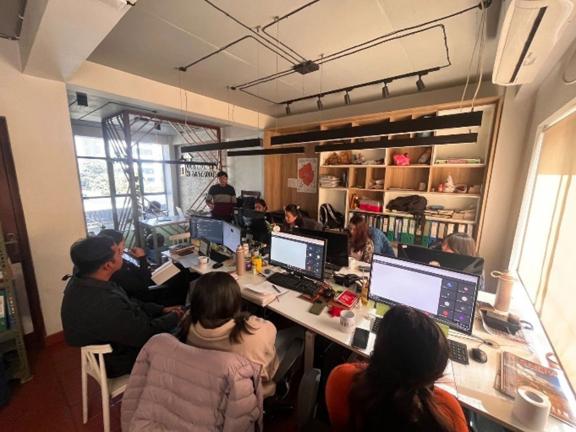
Source: Rubik Joshi
1. Use AI to Grow Your Business
AI offers many opportunities to speed up the growth of your organisation or destination. AI can help automate and improve the quality of your marketing and sales tasks. It can help you stand out from the competition with innovative ideas, assist in creating well-defined USPs, and attract customers and B2B buyers. But it does not’ do that all by itself; it needs to be directed by a knowledgeable human with a clear and well-structured strategy and planning to do its job well.
If you haven’t defined a strategy yet, start doing that now with the help of the following video.
Video 2: AI Tourism Content Creation: Research & Planning
2. Using AI in B2B Sales
Securing more B2B partners or increasing sales to existing buyers is a continuous and long-term effort. First, you will find an overview of how AI can help in the various stages of the B2B sales journey, followed by practical examples of using AI to enhance your B2B sales.
Table 1: Overview of how AI can help during the B2B sales cycle
| Phase | Actions for Tour Operator | How AI Can Help |
| Awareness | Build a consistent online and offline presence that brands your company in line with your strategy using your vision, values, value proposition and USPs. | Use AI to create strategic and planning documents, as shown in the AI Tourism Content Creation: Research & Planning Video. Make content using AI for marketing materials and channels like blogs, brochures, and social media using tools like ChatGPT, Jasper and Copy.ai, as seen in several examples throughout this document. |
| Identify and find European buyers (travel agencies, tour operators, OTAs). | Use AI-driven market research tools to create and analyse buyer profiles and find and scan online buyer’ databases with AI tools such as Gemini and Perplexity. | |
| Attend trade fairs and networking events to showcase products. | Create AI-powered PowerPoint presentations with Microsoft Copilot. Send invitations created using AI and manage meetings with CRM systems. Look for integrated AI solutions in office suits and tour operator software. | |
| Consideration | Make itineraries and pricing information. | Co-create itineraries with AI applications like ChatGPT or use dedicated AI itinerary creation software, which is appearing in more and more tour operator software tools. |
| Meeting online, managing leads and creating follow-up communication pipelines | Combine online meeting tools like Zoom with AI tools for automatic follow-up and Go-To-Market Solutions like Copy.ai, Zoho, HubSpot and Salesforce Einstein. | |
| Offer educational content that answers questions about your experiences and destination. | Use AI to create interactive materials that help buyers learn about your destination and company with tools like NotebookLM. | |
| Decision | Draft and negotiate contracts with clear terms and commissions. | Use AI chat apps like Gemini to draft and understand contracts and comply with rules and regulations. |
| Showcase reliability through testimonials and case studies. | Use AI chat apps that can access the internet, like ChatGPT, to extract and highlight reviews and testimonials. Create professional portfolios showcasing what customers think about your company and how you can make a difference for other tour operators and agencies with the integrated AI design tools of Canva or Microsoft 365. | |
| Act quickly on inquiries and maintain regular communication with prospects and partners. | AI chatbots and AI customer agents like Intercom for 24/7 buyer support and AI-suggested responses to emails and inquiries to speed up the process. | |
| Retention | Offer post-tour support and feedback collection. | Use AI tools to automate post-tour surveys and analyse feedback for improvements with Gen AI chat applications or dedicated AI-driven survey tools like Survicate. |
| Keep buyers updated on new products or market trends. | Use AI-based email marketing campaigns with tailored updates for buyers using tools such as Mailchimp and Moosend. | |
| Gather content created by travellers and share it with your partners | Use AI to generate emails in which you encourage travellers to share content and select the best photos you collected with AI to be shared with partners. |
Source: Peter Fabricius and Guido van de Graaf
Leading buyers to a sale
A CRM system can help you manage and lead your buyers through the sales journey. Several CRMs have started integrating AI, making lead management smarter by assisting you with who to contact, the best time to reach out, and the ideal next steps based on engagement levels and behavioural data. Examples of tools offering these features include Apollo, Salesflare, Pipedrive and Freshworks, or dedicated software like Moonstride.
Copy.ai is a tool that combines content creation with lead management, info bases and a CRM. The system supports contacting, following up and creating messages.
Nepal-based Aarya Technology from Binod Adhikari, a former CBI-supported tour operator, developed a complete Travel ERP that includes lead management for tour operators.
If you prefer not to use specialised tools or want to start small, your preferred AI tool can assist you in guiding B2B buyer customers through the sales cycle. It can help to create a central database or spreadsheet solution, such as Google Sheets or Airtable, that can track conversations and offers. AI can then help with the whole process, from finding and contacting to analysing your communication with buyers, providing suggestions, and even drafting emails and other marketing materials you need to turn your prospect into a long-term partner.
In the following section, we provide a whole workflow; you can use the examples as individual steps or try to rebuild the entire workflow for your company.
Create a B2B sales plan that defines an action plan and a buyer profile
AI can increase your B2B sales by helping you search for potential buyers, prioritise your most valuable leads, improve conversion rates through personalised communication and recommendations, and advise on the best next steps in your sales process.
To let AI assist you in the sales process, you need to create a B2B sales plan with SMART goals that are specific, measurable, achievable, relevant and time-bound so that AI can understand what you want. You must also define who you are targeting with a buyer’ profile. Add a framework like the B2B sales journey in Table 1 that provides different steps to guiding a prospect to a long-term partner from awareness to retention.
Figure 2: role of website in B2B marketing
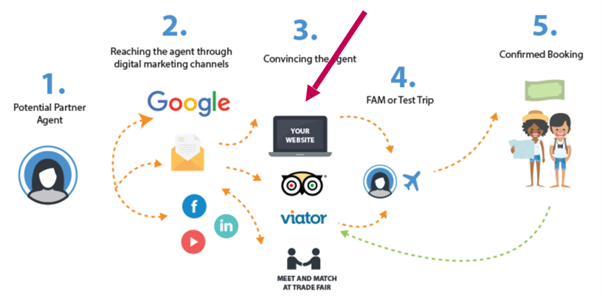
Source: Peter Fabricius/CBI, 2018
Using a sales framework makes it easy to plan actions like creating marketing content, finding buyers, sending cold emails, going to a trade show and organising familiarisation trips for each stage of the sales journey. Add from your strategy which experiences to sell with which USPs and value propositions so AI can assist you with the best-targeted advice. See, using AI in this process is like getting the help of a consultant or digital marketing agency; they can only help you if you provide your business details.
To use CBI market knowledge, refer to the correct CBI market entry document for your niche, which you can find through the niche wheel.
Key elements to include in the sales plan:
- Buyer profiles that describe company details like size and budget, the niche, its needs and challenges, and factors influencing the buying decision.
- A table or overview of the buyer’s journey, from awareness to retention, that defines what to do at which stage:
- Awareness: Highlight unique experiences.
- Consideration: Use AI to address pain points, like cost savings and ROI.
- Decision: Simplify processes with tools like contract automation.
- Retention: Leverage AI for personalised follow-ups and loyalty programmes.
- Planning actions you are going to take, such as:
- Making a prospectus.
- Finding buyers.
- Sending cold emails.
- Visiting Trade shows, such as ITB Berlin or WTM London.
- Holding online meetings.
- Organising Fam Trips.
For ideas on how to make a sales plan with AI, you can use the StorySafari example prompt and conversation with ChatGPT to create a B2B sales plan.
Figure 3: Example of a prompt to make a B2B sales plan with the RTFCG (Role, Task, Format, Context, Goal) framework
We have attached StorySafari’s basic strategy and referred to our website for context. We asked AI to use the B2B customer journey as a format and use CBI knowledge from Entering the European market for community-based tourism.

Source: Peter Fabricius & Guido van de Graaf
Figure 4: Part of the response of ChatGPT with suggestions for a sales plan
3 points from the ChatGPT suggested sales plan
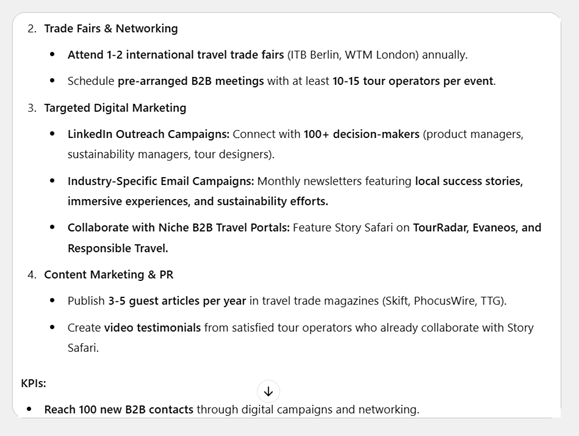
Source: Peter Fabricius & Guido van de Graaf
When creating a sales plan, do not’ accept a first response; give feedback, ensure the plan is realistic and discuss it with the team. AI can think optimistically and with ambition. To make it easy to work further on what you had, copy your sales plan to document that you store in a central location like StorySafari does,
You can use this prompt to create a B2B buyer profile, which is a good addition to your plan because it will help AI find those potential buyers most likely to become new customers.
Figure 5: Organising your planning documents in a could solution like Google Drive

Source: Peter Fabricius and Guido van de Graaf
Finding B2B Buyers
To find potential B2B buyers, let AI search the websites of BSOs, tourism support organisations, and sector association websites that host online databases with members in your target market that match your niche. Use trusted resources like CBI’s tips on finding buyers in the European tourism market and Market Entry reports combined with deep research tools in Gemini to identify these databases and select potential businesses to connect with.
You can ask the AI to search for companies that offer tours in your same niche and/or offer the same outbound destinations. Create a spreadsheet or database with company names, niches, target markets, contact persons, websites, email addresses and LinkedIn profiles. Ask AI to help you collect the data and enter that into a CSV file you can import into your sheet or database. You might notice that not everything is filled in or the data is in the wrong column and that you must take extra steps to verify and restore all data. If it doesn’t work, break down the process into smaller steps. We have been experiencing inconsistent results in automating this process with AI. It is wise to try different AI agents and/or use a dedicated tool if you use this a lot.
To find the right contact persons at these companies, scan their websites for the About Us or Team pages, and use Facebook and LinkedIn search tools to look for job titles such as Operations Manager, Overseas Project Manager or Destination Manager.
Using the LinkedIn Sales Navigator, in combination with communication assistants like evyAI, is a big time-saver for connecting and communicating with buyers.
Please note that as soon as you start logging data about humans, you must write this in your terms and conditions and privacy statement and store the data on a secure server.
Figure 6: Using evyAI in combination with the LinkedIn Sales Navigator lets you write connection invitations to buyers based on your LinkedIn profile and the buyer you are targeting
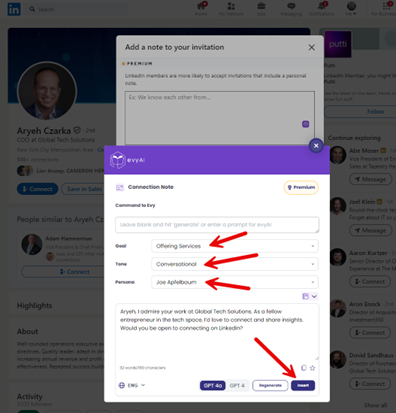
Source: evyAI
Contacting buyers
When contacting buyers, showing and proving that you offer something unique that aligns with what they are looking for is essential. This is sensible business, and EU (GDPR) law prohibits sending any unsolicited email to a business that does not’ have value and if the company does not’ have some interest in your service. And not at all when you send it to a person working for a company; you need permission or an existing connection through LinkedIn for example. Another way of getting permission to collect contact data legally is to collect email addresses and contact details through your website, for instance, by offering free destination guides or podcasts with the latest news in your niche that people can access in return for an email address.
When contacting companies through email, you must always have your email, name, company, address, contact details, terms and conditions, and references, as well as a privacy statement, in your contact emails so that they can opt out of unwanted emails from your business.
To create valuable emails, use AI to help craft emails with input from your buyer’s profile, strategy and research results.
When you have a hot prospect that shows interest, you can customise AI advice per buyer by letting AI find information on the buyer’s website and social media profiles of the company and the person you are engaging with.
Additionally, you can use AI to research and analyse the customer’ reviews of this company to understand their perceived strengths and weaknesses.
Collect and store this information per buyer in a structured document with separate sections for general company information, decision-makers, needs, pain points and customers they serve. If you are collecting and storing data, you need to mention this in a privacy statement, especially when collecting personal data about someone’s role. A person always has the right to ask you to see and delete all the information you have about them.
Ideally, you would be using a CRM tool for this, but a spreadsheet with links to documents could also work.
If you have collected information about potential customers, creating emails and marketing materials and preparing for sales talks with AI will become valuable and targeted. For the best results, use a structured setup like StorySafari. If you are unhappy with the results, improve the outcome by showing AI what you edited. Ask what it needs from you to generate a better result next time. You can then adjust one of the documents.
Figure 7: Prompting AI to write an email to a B2B buyer
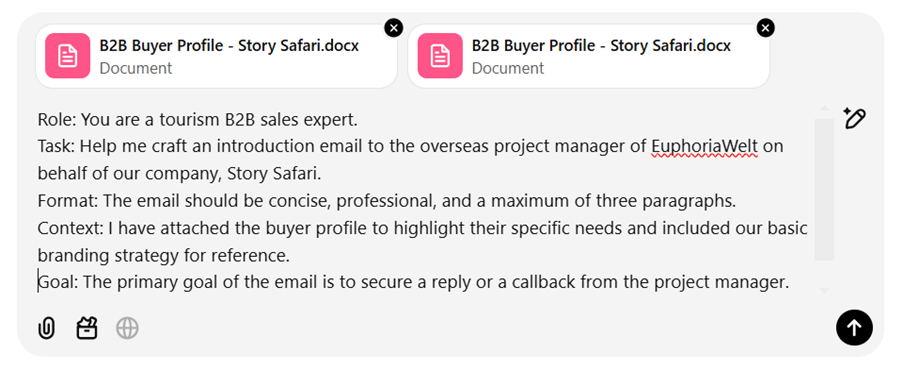
Source: Peter Fabricius and Guido van de Graaf
Find here the Prompt: B2B introduction email
Figure 8: Response of AI to write an email to a buyer
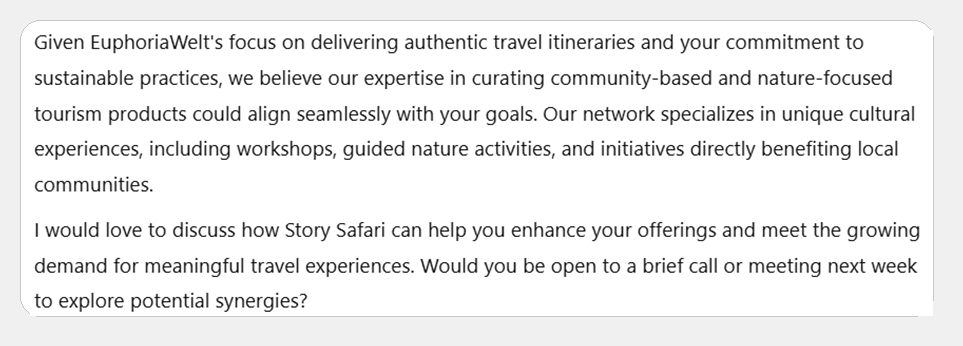
Source: Peter Fabricius and Guido van de Graaf
Give feedback and edit manually to improve the response, then ask the AI what it needs from you to achieve the same outcome next time in one prompt. Based on that feedback, you can adjust your prompts or guiding documents.
For detailed instructions on using AI for Email Marketing, see the video AI Tourism Content Creation: Email Marketing of CBI.
Workflow Example:
- Use AI-powered tools like ChatGPT or Gemini to draft buyer profiles.
- Map a buyer’s journey based on CBI’s niche market insights.
- Identify and select buyers with portals like ETOA member search.
- Connect with buyers using AI-optimised or prepared emails, messages and calls.
- Automate tailored communication materials for each stage in the buyer’s journey with AI tools.
- Track progress and refine strategies using AI analytics.
3. Prepare and follow up for trade shows
When attending a travel show, AI can help you invite customers and encourage them to stop at your stand by creating marketing materials, designing your stand and generating ideas for actions to draw people to your booth, such as gamified activities or interactive displays to engage attendees. Ask it to help you and use your strategic and planning documents for context.
AI is also highly effective at crafting elevator pitches. First, co-write the pitch with AI and then practise in front of an AI screen that gives you direct feedback on your performance.
Figure 9: prompt in DeepSeek to create a sales pitch
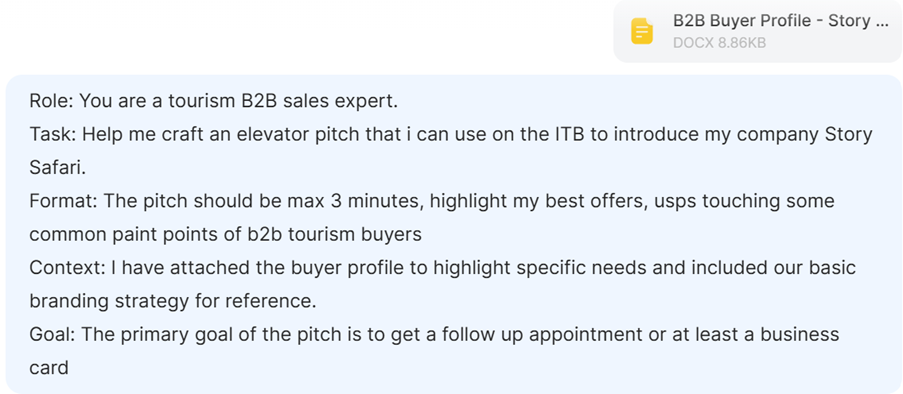
Source: Peter Fabricius and Guido van de Graaf
Figure 10: Response of DeepSeek with an example elevator pitch for ITB
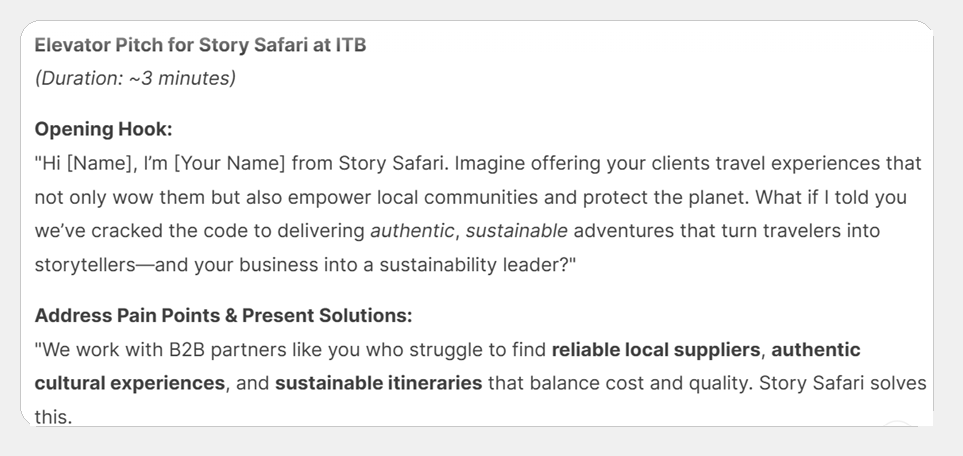
Source: Peter Fabricius and Guido van de Graaf
Visual : Create elevator pitch, practice in front of Google AI studio and get live feedback
Contract Management
Drafting and understanding contracts can be challenging, as they must comply with the law. They also contain difficult terms and must cover your risks where possible. AI can assist by explaining complex terms in simple language, draft contracts and review them to identify potential risks or suggest topics for further negotiation.
If you need to draft a contract, you can search for contracts online and ask AI to modify them to fit your situation.
4. How to use AI in B2C Sales
The section below will focus on how to use AI to guide travellers to booking.
Changing Customer Journey
In the last few decades, Google Search and OTAs have played leading roles in selling tourism experiences to travellers. The future role of Google and OTAs in the sales process is still uncertain, but we are beginning to see that travel websites are receiving less traffic from Google Search and more traffic from AI Assistants like ChatGPT.
With the arrival of more intelligent AI agents and the ease of making travel plans with an AI Assistant or an AI itinerary builder, more travellers will start using AI to plan and book their holidays. How fast this transition will go is uncertain, and it will depend on the degree to which the public will trust these systems and how easy they are to use. Complete customer journey automation will take time and will happen first for ‘easy’ to automate allotment bookings like flights and hotels. We are already seeing that AI itinerary builders like Layla are starting to become pretty smart and can complete the planning process from start to finish. But when you want to book, they will refer you to OTAs. When you begin to ask complicated, detailed questions, such as “my hotel needs to be within walking distance, close to public transport, provide free breakfast and a bicycle for hire”, the results are poor in OTAs like TripAdvisor, but get clever in Layla.
Figure 11: Planning a holiday in Jordan with AI Itinerary tool Layla
You can see that Layla tries to understand you and makes an almost human-like conversation.
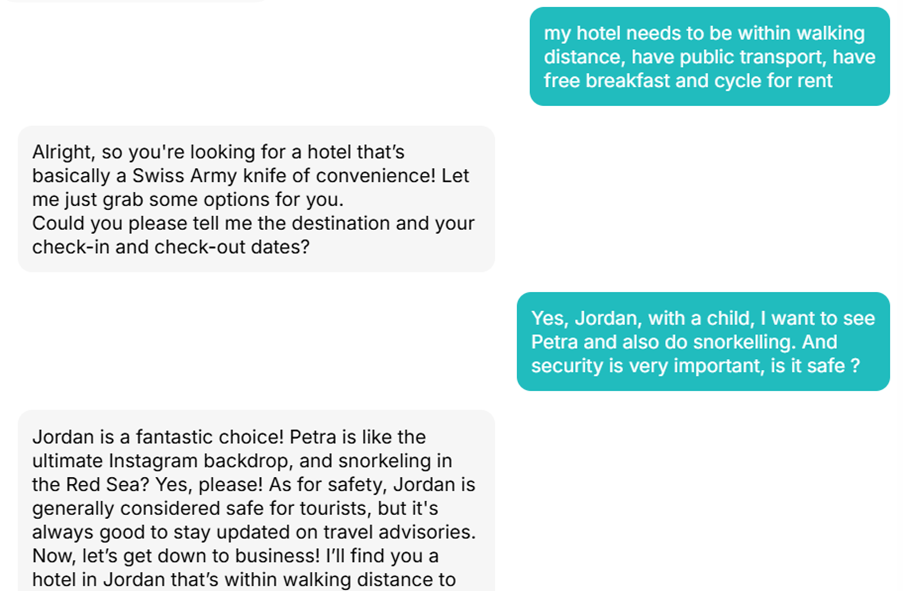
Figure 12: Planning results of a tour in Ethiopia with AI Itinerary builder Layla
Planning in Layla is mind-blowing, but to book the food tour, you are sent to GetYourGuide.
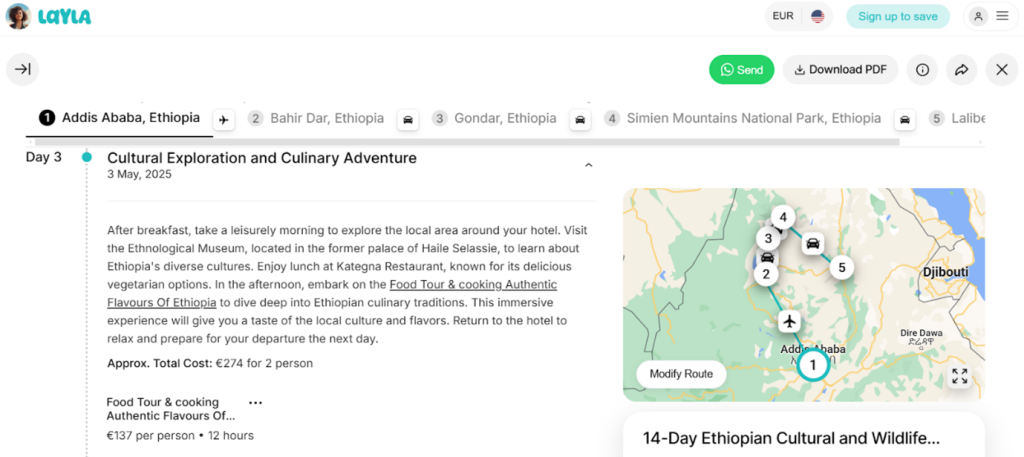
Source: Layla
Where Layla sends travellers to OTAs for bookings, DeepSeek can also send travellers to the tour operators’ websites to finalise their bookings.
Figure 13: In DeepSeek, the system sends travellers who want to book to the website of a tour operator

Source: Peter Fabricius and Guido van de Graaf
Now, more and more travellers are starting to use AI to plan their holidays with ChatGPT, Gemini or AI itinerary planners. Your website will be visited less frequently; the AI will pull your website information into the chat window. As a result, travellers will spend less time navigating websites, social media and videos to plan their travels. They will probably continue engaging in the fun parts of the customer journey, such as getting inspiration through offline media, TV, social media, travel videos, and from friends and family. At the same time they will let AI agents handle the planning for now, putting booking back into the hands of the traveller.
In summary, travellers will probably stay active in the awareness phase, dreaming away through beautiful videos and visuals. But we will start using tools that help them automate the planning phase and, later, the booking phase. To prepare your business for these changes, go through the sections below.
5. Digital Marketing with AI
Not everything is new. While working with AI, the marketing principles and concepts described in the study on how to be successful online are still valid. You must inspire travellers to visit your destination and enjoy your experiences through unique content that tells engaging stories and includes attractive images and videos. Brand your unique value proposition across all communication channels, setting yourself apart from the competition. Ensure that customers can easily find answers to their questions, address their concerns, back your claims with social proof and close a sale.
Figure 14: An excellent example: Clear Product + USP + Social proof by Source Ethiopia Tours

Source: Source Ethiopia Tours
A six-video series on creating tourism marketing content with AI explains step by step how to amplify your digital marketing communication with AI in combination with CBI market information.
When you have gone through the videos, understand prompting and publish your first co-written AI content on social media and your website.
After going through this series of videos, or if you feel confident creating with AI, start thinking about how to shift from creating individual content pieces to a series of well-planned content creations aligned with your digital marketing strategy, telling your company’s and destination’s stories.
Make a digital marketing plan based on your strategy that describes the channels and the kind of messages and information you will create to lead your target audience through the different phases of the customer’s journey, from awareness to booking.
Based on your digital marketing plan, strategy and persona, create an overall content plan that plots a series of messages and describes what content you will make, when and for what platform, to tell an integrated story that brands your business on your website and social media.
The StorySafari example tour operator has a structure in its Google Drive to create a series of integrated content with example prompts. The drive contains the above-described prompts for a digital marketing and content plan. Edit the prompts to fit your company; please note that the prompts are not good enough to create perfect content. They are meant as a kickstart to help you set up such a system.
Storing and reusing prompts, like those shown in the StorySafari drive, helps your company constantly improve your prompts and, with that, the quality of your digital marketing.
Figure 15: Screenshot of the Google Drive of StorySafari that shows a series of planning prompts
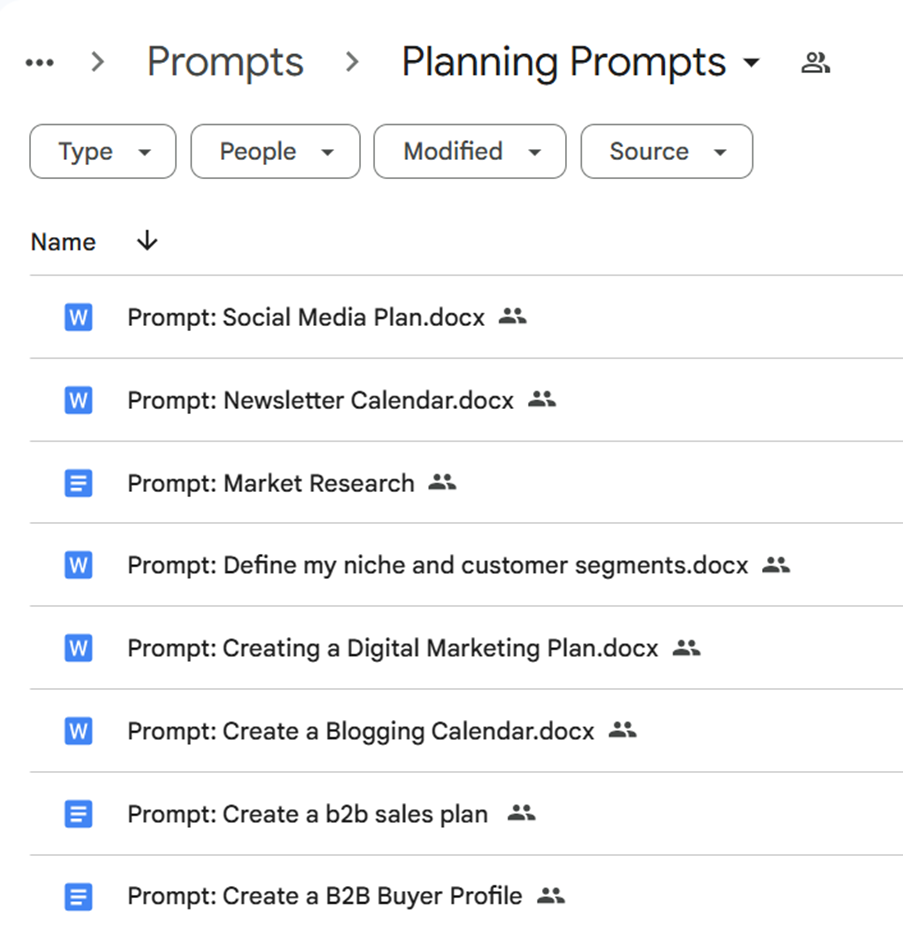
If you don’t want to create such a setup, use a platform like Jasper to create content in an integrated prebuilt system.
Workflow to create content that leads customers to a sale
- Make a strategic document that defines goals, target markets, persona, USPs
- Create a digital marketing plan that describes and plots your channels and messages
- Create a content calendar
- Create the content
How do you let your business appear in an AI chat response?
In the changing b2c customer journey section, we discussed that more travellers will interact with AI to plan their holidays. With AI Assistants and AI holiday planners, travellers will get all the information they need about destinations, experiences and accommodations directly in the application’s chat. The booking phase of the customer’s journey is currently not part of AI apps. Bookings and reservations happen on OTA’s and companies’ websites. Your tourism business needs to be listed in their suggestions to get business from these AI apps, but there is probably only room for a maximum of three different alternatives. Therefore, just as optimising your website for Google with Search Engine Optimisation (SEO) ensures visibility through high rankings, it is essential to optimise your digital presence and website to be visible in AI tools by helping them to pull your content into their response. People started to call this technique Generative Engine Optimisation (GEO).
Most SEO rules also apply to GEO: Create value for your customers at all stages of the customer journey, and rankings will follow; be focused; have a well-defined niche, and make sure you show you understand the needs and the pain points of your customers by providing them with inspirational and helpful content in combination with social proof.
Video 3: Create Content with Value that Inspires, Helps, Proofs & Sells
What is new is that people converse with AI systems, making their requests more specific than when you use keywords in a search engine. The answer of an AI assistant will also be more specific.
For example, a user might type or say, “I want to go on a child-friendly tour that is fun, entertaining and educational in Uganda, mixing Gorilla-watching, swimming pool and good food experiences”.
If your website ticks all these boxes, AI will understand your content better, and it is more likely to appear in the AI system and be matched to the right audience. Create content that explains your experiences in detail and is targeted to your persona. This does not’ mean you need long text; an image says more than 1000 words, and a video even more. Where traditional search engines have difficulty understanding what those visuals are about, this is no problem for AI. These visuals must be in line with your niche and positioning. Do you show families if you are targeting family travellers? Are your USPs reflected in the content?
Figure 16: Visual Representation of a family having a good time in Uganda from Msafiri Tours and Travel

Source: Msafiri Tours and Travel
But be focused; start with your top-selling experiences. Let AI help you suggest which details and content to create based on your company data, strategy, research and CBI market documents.
For everything else, you will still need to ensure your company is visible all over the internet: on maps, social media, review platforms and through OTAs. This will not only help to give AI extra pointers to understand how valuable your company is, but the system will also pull content from these sources. We discuss this in more depth in the following sections.
Watch this video to learn step-by-step how to use AI for your social media
Video 5: Improve your social media presence with AI
Some companies have started blocking AI agents from scanning their websites. That is a measure that might be counterproductive. Yes, AI won’t be able to share your itineraries with competitors, but customers will also not be able to find your business. Your competitive edge should be how you deliver the experience, not the description of it.
Maximise your visibility in mapping tools
Dedicated AI itinerary builders and general AI Assistants like Claude and Gemini use structured data from sources like OTAs and mapping tools like Google Maps.
If you want to be named as frequently as possible in AI systems, ensure your Google Business account is verified and optimised with your latest company data and plenty of photos and videos. Do not’ forget to encourage your customers to leave reviews because more reviews also help with your visibility. It makes sense that Gemini and integrated Android AIs will depend on Google Flight, Hotels and Things to Do; you might get yourself listed in one of those Google services through an OTA, but you can also get listed through several software solutions.
Figure 17: Recommended Accommodations in ChatGPT with a Google Map View
This clever mash-up of the ChatGPT response shows a Google map of a route and stops combined with a block filled with accommodations recommended by a British newspaper, The Times and a link to the hotel website.

Source: Peter Fabricius and Guido van Graaf chatting with ChatGPT
There is no such dominance in AI assistants and tools as we see with Google in search; different AI companies have different licensing agreements with varying map providers. Maximise your map listings visibility by adding your business to Bing Places, Apple Business Connect and Open Street Map.
Have an active social media channel
AI itinerary builder Layla, which collaborates with influencers, is known for adding social media content in its visual presentations of AI-created itineraries, to inspire travellers and help them create their dream itineraries. It combines this with bookable accommodations and experiences from OTAs like Booking.com and GetYourGuide.
Figure 18: Part of the Itinerary presentation of a 14-day tour in Ethiopia in Layla
On the left, we see a tour description, and in the middle, a visual from social media.
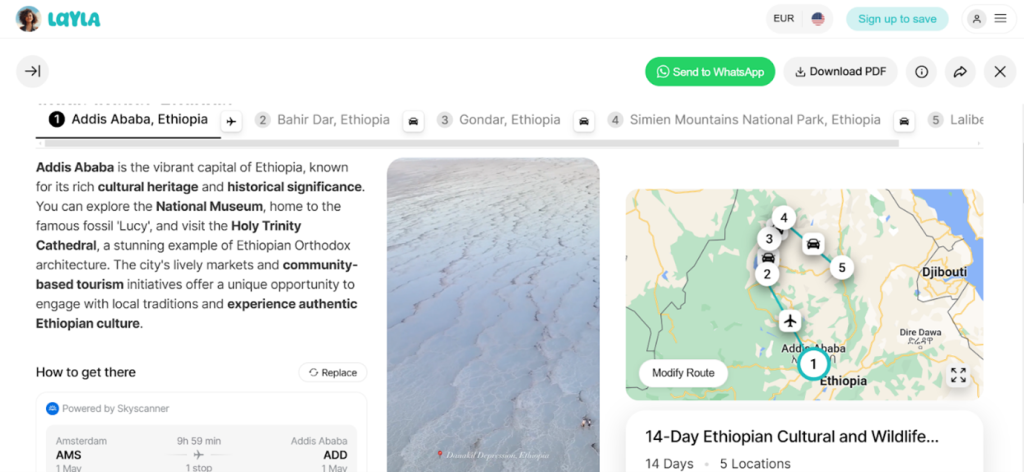
Source: Layla
Update your social media channels frequently with stunning, detailed visuals and videos that visualise your niche, and target audiences that will enjoy your experiences and destinations. Don’t forget to Geotag the location where the photos and videos are made. This is important because automated systems pull the best photos from locations tagged with geotags.
Figure 19: Instagram post geotagged with Karnak Temple, Luxor, Egypt
On the left side of the orange arrow, you will see the geotag

Source: Instagram
Using OTAs
The role of OTAs in the future is unclear, but in the short term, having your tours and experiences distributed through OTAs is advantageous if you want to be included in AI-created itineraries. AI-itinerary builders, such as Layla.ai, are currently fed by OTAs, and it is likely that most AI agents launched in the coming years will use OTAs as their preferred source of tours because they are the easiest to integrate with.
Figure 20: Layla shows flights from Skyscanner, hotels from booking.com and experiences from GetYourGuide
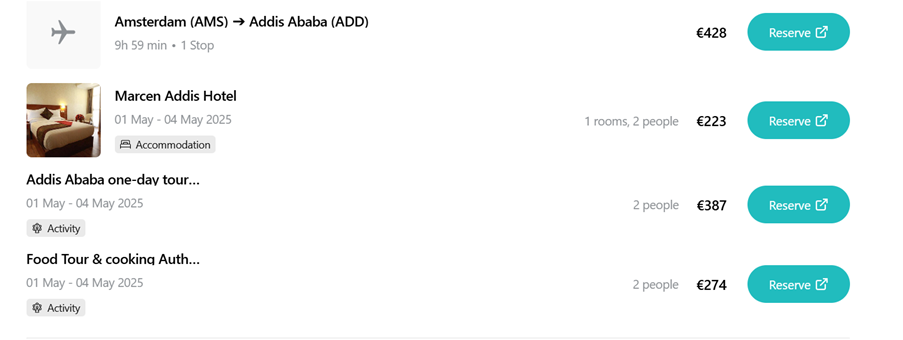
Source: Layla
Channel managers that help to distribute your tours and experiences in different OTAs are also becoming more intelligent and help by commenting on and analysing reviews, like Magpie.
Tips:
- Stay informed about SEO trends to adapt your strategy. Read articles that share tips and tricks for appearing in AI Assistants.
- Provide a structured presentation of your tours, experiences and offers, according to industry standards like XML, so that AI systems can understand them easily and will help distribute your offers as widely as possible.
- Look at your website’s analytics in the traffic sources to monitor shifting patterns in how your audiences find your website and how much traffic is coming from AI Assistants.
- Add your tours in OTAs so AI tools can find them and make them appear
- Think about how you want to appear in Google Things To Do through an OTA or software partner; find the complete list of possibilities on the Google website.
Figure 21: ChatGPT appearing in traffic sources of websites
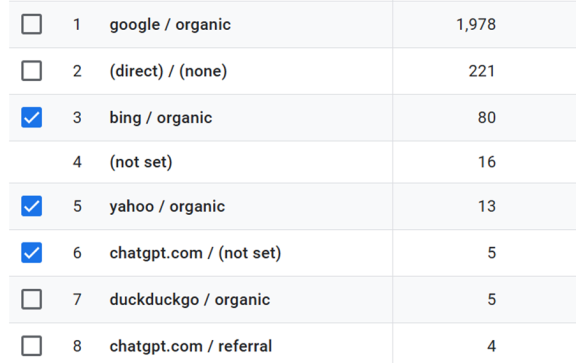
Source: screenshot of Google Analytics
Website
More and more tools are appearing to improve websites with AI. Tools like Relume can generate sitemaps, wireframes and even complete design blocks based on text prompts. Other examples are Wix, which has introduced its AI website builder, and WordPress, which offers several AI plugins.
Although websites’ roles and interfaces may evolve in the future, the content management system (CMS), the backbone of most websites, will remain essential for digital marketing and play a central role in your content distribution.
Kontent.ai is an example of a provider already working with this idea. It offers a hub to create and centralise all your content, which can be distributed across multiple websites, email campaigns and social media platforms.
If you want an AI itinerary builder on your website, TRVLR.ai offers this technology to destinations and companies.
AI-powered tools help you rank at the top of search engine results by helping you identify what content to write and which keywords and headings to use. Tools like Surfer SEO and Semrush are excellent examples.
Once your website reaches at least 1,000 visitors a month, you can experiment with AI-driven optimisations to create the best possible website through A/B testing. For example, VWO provides solutions to test which design and content elements work best. If you do not yet have this level of traffic, you can use tools like Google AI Studio or other AI feedback systems that can give you feedback on a shared screen to evaluate usability, strategic alignment, SEO and any other questions you might have.
Watch this video on using blogging with AI
Video 4: AI for blogging
Tips:
- Use an experience/tour management system like FareHarbor, Xola or TrekkSoft, which can feed your experiences and tours through an API to OTAs and AI Agents.
- DMOs want to build what some, like Hubcore, call digital warehouses where they store their destination information and experiences
Figure 22: Google AI Studio giving feedback on the website of Luxor Egypt Tours
Google AI Studio gives voice feedback and writes the transcript of the conversation.
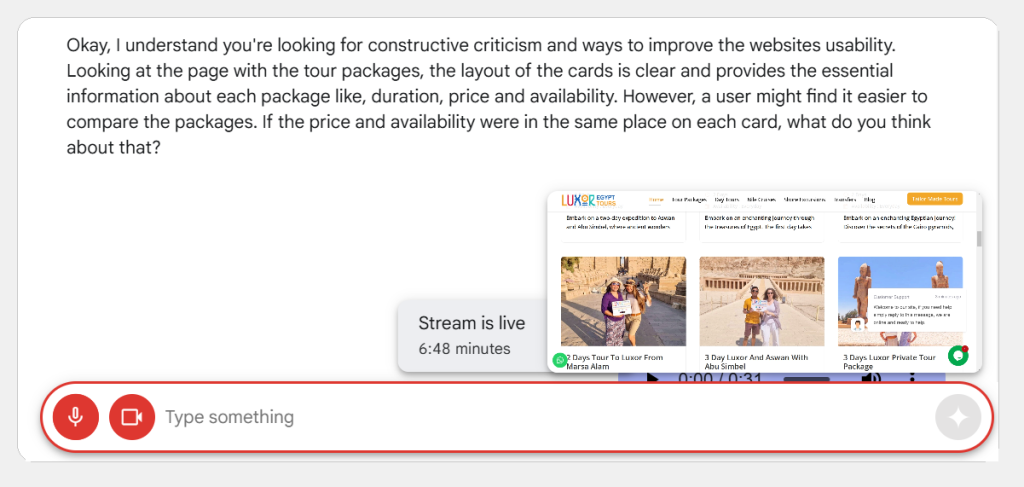
Source: Peter Fabricius and Guido van de Graaf interacting with Google AI studio
Personalisation
Personalisation is the ultimate transition from mass media communication to one-on-one communication at scale. It allows organisations to communicate with customers based on their travel history, personal preferences and other insights, helping to create automated communication that feels like it was done by a human who knows this person, like a friend or long-term relation.
An everyday example of personalisation as we currently know it is the personalised feeds on social media and favourite music and video streaming services.
Figure 23: An AI-powered personalised itinerary from Mindtrip.AI

Source: Mindtrip.ai
Many SME tourism companies implement personalisation naturally in their communication. Their trips are rarely standardised, and nearly every customer receives tailored advice.
Then why does personalisation matter for you?
AI can scale personalisation across all communication channels, including email newsletters, websites, chatbot interactions and post-trip follow-ups. It can even do this in the customer’s native language with minimal human intervention. You achieve hyper-personalised communication by providing each customer with uniquely tailored messages throughout the customer journey based on their individual needs, preferences and behaviours.
Chatbots are also a part of personalisation. These virtual assistants help with customer communication by handling questions themselves. Bots can help with a variety of tasks such as reservations, inquiries and personalised recommendations, and are rapidly getting better.
Research shows that 87% of customers prefer using travel chatbots if they save time and money, and 70% find them helpful for simple inquiries.
Since bigger companies have started using personalisation in communication, it is becoming a communication method that more and more customers are beginning to expect from companies. They will be surprised or annoyed when they receive irrelevant information in their mailbox or chats.
For example, Germany employs an AI-powered chatbot named Emma to assist visitors with travel planning.
Figure 24: ChatBot Emma for the German Tourism Board

Source: Germany Travel
Figure 25: Emma even has an avatar that provides travel advice on Instagram
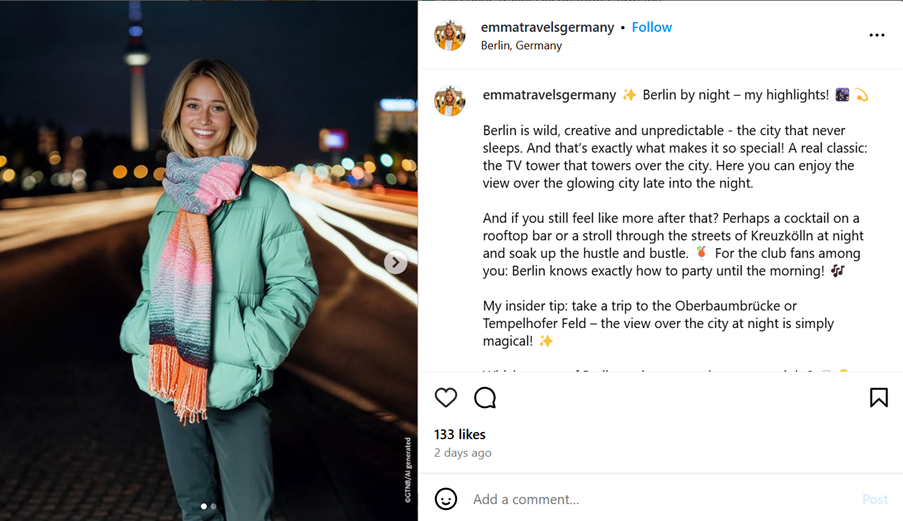
Source Instagram
There are many tools to build your chatbot. These tools work by feeding or training them with all the information from your website or other sources from your company. Based on this knowledge, they will answer customers’ questions by themselves.
Considerations when selecting a chatbot for your organisation
Customisation Options: Ensure the chatbot aligns with your brand’s look and feel and that you can customise its behaviour based on your business. Before implementing, perform tests to verify that it satisfies your specific operational needs.
Security Concerns: What happens with the data your customers enter? How safe is it, and how does the bot communicate with potentially sensitive data? Safeguards against misuse, such as prompt injection attacks, which are deliberate attempts by users to derail the bot and manipulate the bot’s functionality, should be in place. Choose chatbots with robust security features to identify and block malicious behaviours.
Multichannel and integration: Can the chatbot be active and recognise customers on different channels? Can the bot be integrated with other systems in your tourism organisation?
Figure 26: Advanced multichannel chatbot from Quiq
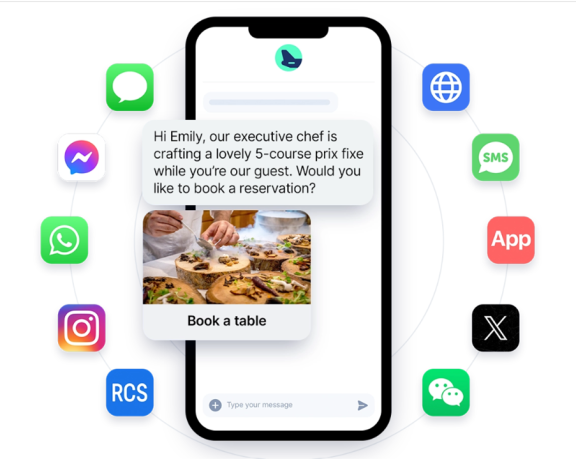
Source Quiq
Models and Updates: Some chatbots let you choose which AI models, for example Gemini, you want to use and are very quick to integrate new versions of models. Choose solutions that update quickly or where you can change which AI model to use to ensure you always have the latest AI technology.
Pricing and data: Make sure you understand the pricing models and what you are paying for. Be clear on whether you have to spend extra for using the AI model separately, if you have to pay that directly to the AI model or the chatbot platform in the form of credits, and what happens with your data if you decide to switch chatbots.
Some chatbots to evaluate: ChatBot, HubSpot Chatbot Builder, Chatbase
Integration and human intervention:
Make sure that a chatbot is integrated with the rest of your communication tools. The bot should ask for help from a human when it cannot solve a problem and should offer the option for users to get in touch with a human when needed. It should also be clear how long it will take before a human can provide assistance. This can be especially challenging with a smaller team. Try to make sure you stay under 24 hours.
With HubSpot Chatbot Builder, you can start with chatbots for free. Other options are Chatbase and Chatwith.
Starting with Personalisation
There are several ways of approaching personalisation
- Customise communication details: adaptations like using a customer’s name, speaking in their preferred language, and a birthday message. You can use merge fields in a Word document or add triggers in your CRM system or email sender like Mailchimp.
- Historical Awareness: Communication based on past customer behaviours, choices and actions. For example, present offers on products a customer viewed previously.
- Contextual: Consider someone’s location, which season or time of the day it is, the weather, or maybe even the fitness levels recorded by a smartwatch. For example, a destination that gives museum tips on a rainy day. Offered by Dotdigital.
- Interpretation: Analyse customer behaviour and feedback to create messages or display content that meets their expectations. This is the most difficult one and needs more advanced tools and enough data.
Figure 27: A banner display only when it rains
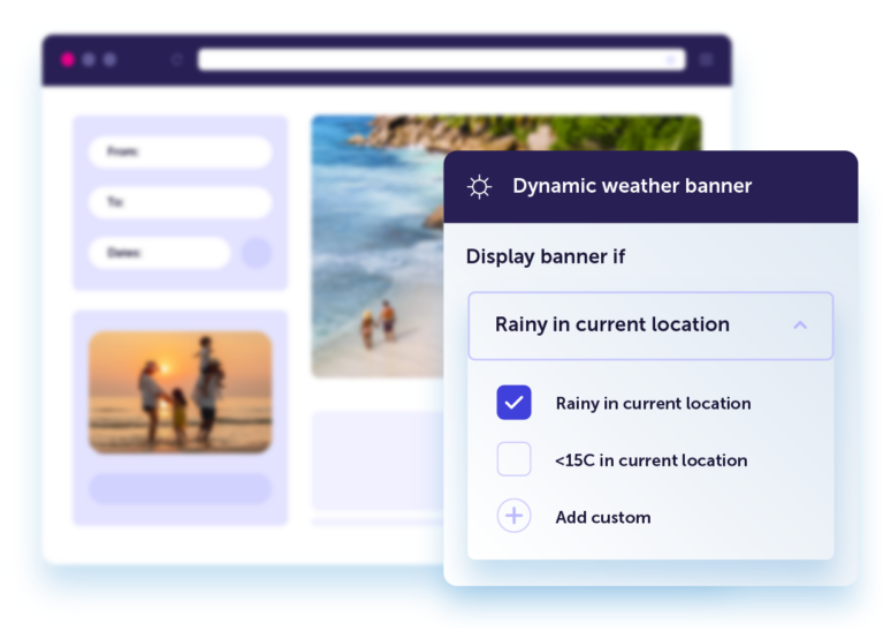
Source: Dotdigital
Start with segmentation
Separate customers and potential customers with AI into 3 or more main segments, for example, cultural travellers, adventurous travellers, and nature lovers. Then send them content they will like based on historical data or their indicated preferences. You can ask AI to divide your customers into several buckets based on criteria. Make it easy for the traveller to see how you segment them and let them change the segment if they like. Tools offering this include Mailchimp.
If that goes well, you can move up to the next level of personalisation.
Figure 28: Process from segmentation to Hyper Personalisation
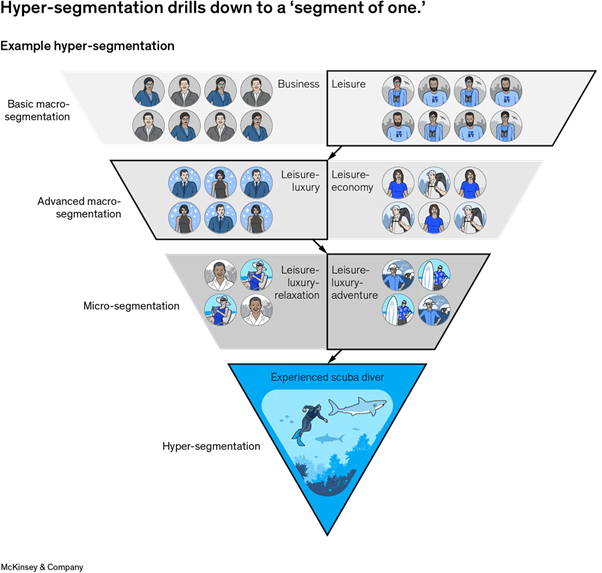
Source: McKinsey
In addition to personalisation in your marketing efforts, you can also personalise experiences. Audio tours are ‘easy’ to personalise with AI. The We Go Trip tours are an example of that.
Tips:
- Start with simple personalisation like mentioning someone’s name or sending birthday greetings with tools like Mailchimp.
- Consider using AI chatbots that can communicate through several channels like ChatBot.
- Look for tools that can help to personalise the travel experience, like We Go Trip.
How to use AI for Market Research
Tapping into the worldwide growth of tourism, understanding trends, customer preferences and shifting market needs, is critical for tourism SMEs and BSOs. Accurate and relevant data and insights help identify the best market opportunities and tailor your services and experiences to customers.
Introduction
Larger organisations often use advanced AI market information tools like Valona Intelligence, which combines big data sets and verified knowledge sources with smart AI tools that enable data-driven decisions for better results. These tools extract that data, present it in dashboards and store it in info bases connected with AI Chatbots, allowing you to ask questions or get advice to work further with these insights.
Figure 29: Example Dashboard of Valona Intelligence
A dashboard that turns industry information into quick insights that help with, for example, better market entry decisions.
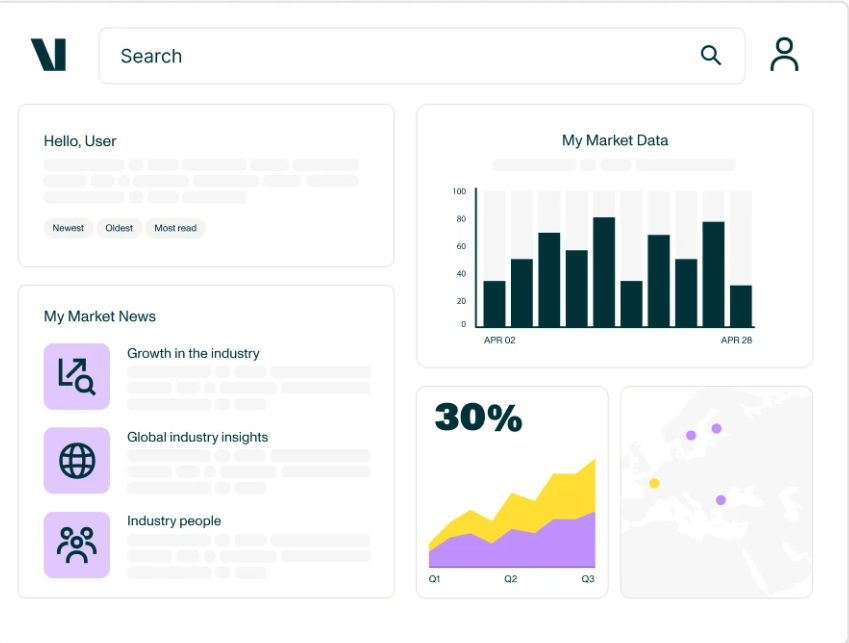
Source: Valona Intelligence
Figure 30: Searching through marketing intelligence with the help of AI
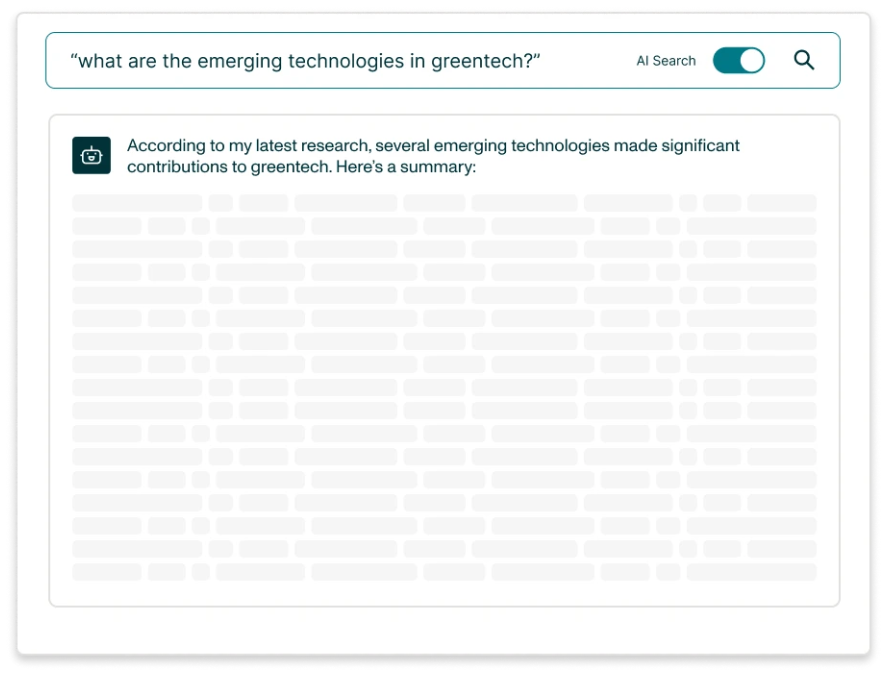
Source: Valona Intelligence
Besides the super smart AI-powered market intelligence systems we see above, knowledge portals like Skift have also started to unlock their knowledge through AI, directly in their published articles and through a Chatbot.
Figure 31: Ask Skift unlocks all previously-written articles through its chatbot
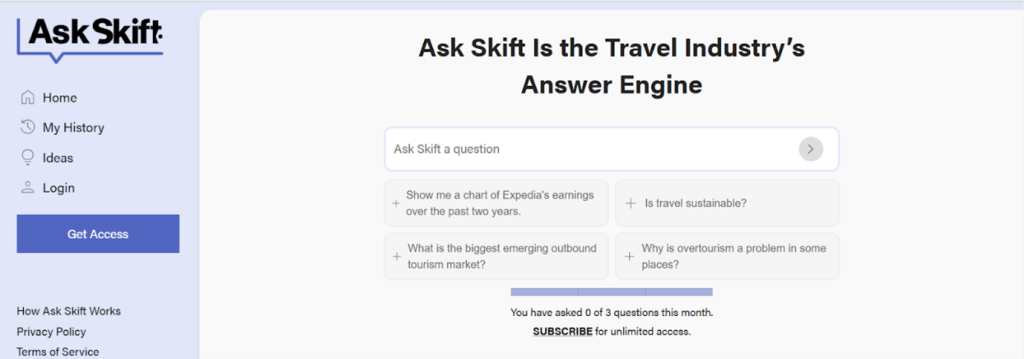
Source: Ask Skift
For SMEs or DMOs with a smaller budget, it is’ possible to use such integrated market information with the help of CBI and AI. CBI provides the latest insights and trends for your market research by offering the latest European tourism market information, divided by travel niche, on its Tourism Market Information portal.
You can use AI tools like ChatGPT, Gemini and Perplexity to help you extract, interpret and analyse CBI’s market information, combine it with other sources and your company’s data, and get actionable insights to create successful strategies and marketing plans and develop experiences tailored to your customers’ needs.
In the sections below, the article shows a series of prompts and a way to store the information to make market research with AI fast, effective and affordable.
By automating information-gathering processes and linking insights directly to strategies, AI empowers tourism businesses to make faster and more informed decisions.
Start by asking questions about a CBI document with the help of an AI system, as explained in this video.
Video 2: Using CBI’s market information with AI
Something that has changed since the video was recorded is that users can ask ChatGPT to directly search online for the latest information by selecting the search button. This is an important feature for market research because an AI model only gets information until the model’s training is finished, which can be over a year ago.
Figure 32: Example Prompt to do Market Research with ChatGPT
See the blue search button to connect ChatGPT with the internet to discover the latest tourism trends.

Source: Peter Fabricius and Guido van de Graaf
Market Research and Trends Scanning
When conducting market research, the best results are obtained if you have defined a clear niche and strategy as context in your prompts. This helps the AI search for and analyse relevant data for your business, niche and audiences.
In the AI Tourism Content Creation: Research & Planning video, you can see practical examples of how to unlock CBI’s market information with AI.
To go beyond CBI as a source, collect more market information. You can implement this as a routine by storing relevant market information when you encounter it in a centralised location for easy access, using knowledge management tools like Notion and Google NotebookLM. These tools allow you to store and organise relevant market reports, websites, and YouTube videos while also enabling you to ask questions and extract insights from the content, as we see in the Skift example.
Figure 33: Market Information collected in NotebookLM
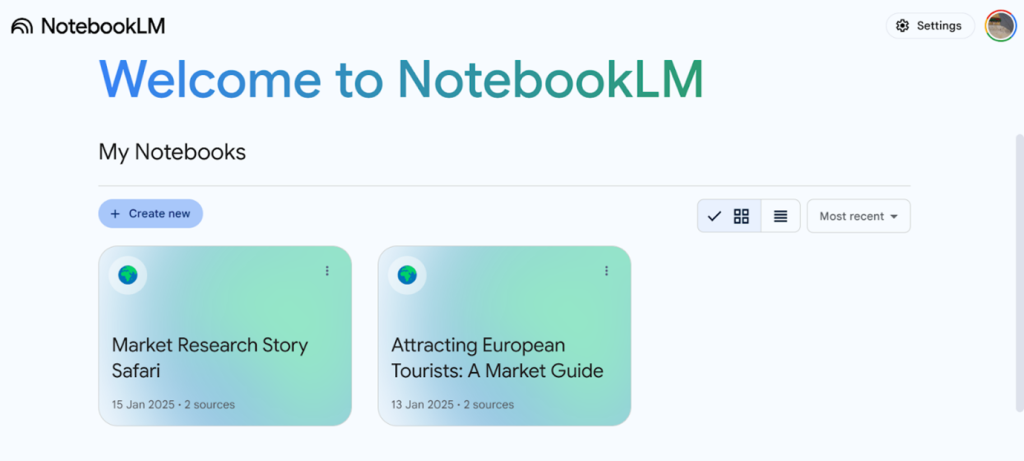
Source: Peter Fabricius and Guido van de Graaf
Great tools for finding the latest market reports and building your knowledge base include setting up AI-powered RSS alerts that automatically search for new publications on topics you want to follow. Examples of such tools are Feedly, Inoreader and the Vivaldi browser.
If you have a paid version of ChatGPT, you can also use its tasks feature by asking it to retrieve the latest travel trends in your niche once a week. You may need to experiment with the prompt to ensure it delivers only the most recent news you are looking for, as the system is still being refined. It helps to indicate every time which news articles were most valuable so that it can learn to deliver you the best articles. A useful feature is that when the responses are presented, you can immediately ask follow-up questions about them.
Figure 34: Example of letting ChatGPT send you weekly travel updates
By clicking on the task, you can change the instruction.

Source: Peter Fabricius and Guido van de Graaf
Figure 35: Editing a task in ChatGPT tasks

Source: Peter Fabricius and Guido van de Graaf
Other tools that can search directly on the Internet are Perplexity, which creates structured reports tailored to your business needs, and Gemini Deepsearch, which can search dozens of websites simultaneously.
Figure 36: Gemini searched 132 websites to help find B2B buyers in Germany

Source: Peter Fabricius and Guido van de Graaf
Figure 37: Perplexity automatically suggests the best follow-up research questions
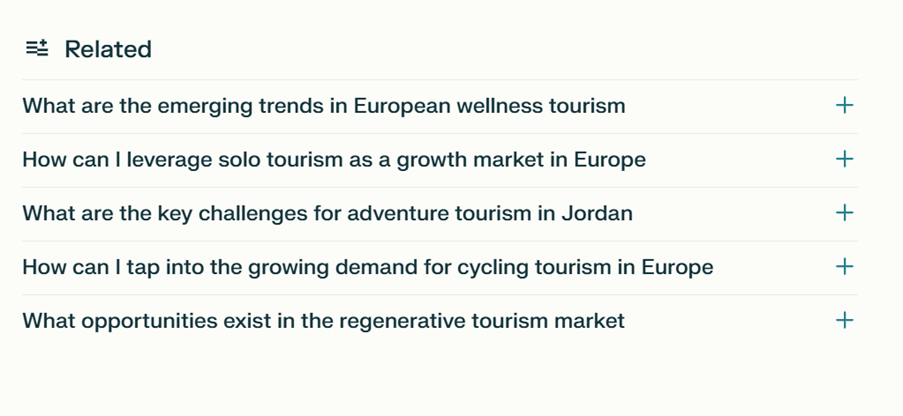
Source: Peter Fabricius and Guido van de Graaf
These internet AI search tools can give you more valuable insights by scanning online discussion forums and social media channels used by your target audience. Identify what travellers discuss and like, and let AI translate that into your target audience’s wants and needs. Use that information to update your persona and buyers’ profiles and to improve your experiences.
Tips:
- Experiment with different tools to collect and store the most useful responses for future reference.
- The real value of AI becomes visible when you combine data, ask follow-up questions and store valuable outcomes in a centralised location for use in other tasks.
- AI might fabricate information if the answer to your question is not in a document or is unknown to the system. To verify whether AI generates accurate responses, you can:
- check the sources referenced by AI and manually verify them yourself.
- specify in your prompt that the AI should stick to the facts provided in the document.
AI Workflow for market research:
- Find and gather data from trusted market information sources, such as CBI, your national tourism boards and UN Tourism.
- Upload this information to AI tools like Google NotebookLM or ChatGPT.
- Extract highlights from the reports and/or ask the AI how the reports impact your business.
- Combine this data with your own sources, such as strategic documents, booking data and customer reviews, to generate tailored insights.
- Store findings for further use, such as refining and creating strategic and planning documents, like a marketing or sales plan, or for product development.
Identifying Market Gaps and Opportunities
AI reveals market gaps by analysing customer reviews, competitor websites, and market data. These insights help tourism businesses identify customers' pain points, unmet needs, and opportunities to develop offerings with little or no competition.
AI is good in Competitor analysis. With tools like SEMrush market explorer you can map out your competitors. After this, you can analyse their unique selling propositions (USPs) and strengths and weaknesses by letting AI scan their websites, reviews, and social media. You can then compare this with your own business and let AI help you position yourself differently with your USPs, craft a sharper Value Proposition, and develop an experience that helps you stand out in the market.
You could also consider creating dashboards that compare your company with others based on reviews. Feed reviews into the AI system and let it analyse customer sentiments and categorise them on points related to your USPs, positioning, and/or the pain points you identified for your persona. Benchmark how your company relates to your competitors in terms of service, fun, family-friendly, etc. This will give you valuable input to improve your services and strengthen your marketing communication.
When doing this, make sure your prompts are very specific and instruct AI to stay factual. To verify accuracy, ask it to take extra steps, such as determining how many people expressed a certain opinion or to display the percentage of respondents supporting a particular claim. Also note that, in general, AI tends to be very friendly towards your business, when you need it to be critical, ask for that.
By storing the outcomes or extending the prompt further, you can compare results with your strategy and other analyses to generate relevant and actionable advice.
To give you some ideas, explore this prompt to analyse competitors
Forecasting with AI
Forecasting helps tourism organisations predict seasonal demand, identify emerging markets and understand the recovery of tourist arrivals after natural disasters or violent conflicts. It also helps them adjust their strategies and plan accordingly. AI tools analyse historical data to uncover patterns and project future trends. This information enables businesses to optimise marketing campaigns, apply smart pricing and plan resource allocation effectively.
Generative AI, as we know from AI Agents, struggles to do this based on databases; they are much better at dealing with unstructured data, and good forecasting systems use different AIs. Generative AI models that now become like a kind of Swiss army knife do-it-all solution start integrating different techniques to do this.
Useful data sources to use with forecasting are inbound tourist arrival statistics from your tourism board, Google Trends, and internal data like Google Analytics and your booking history.
Workflow Example:
- Collect historical booking data and (seasonal) market demand insights.
- Use AI tools to analyse demand patterns.
- Develop marketing and content strategies based on projected trends and forecasts
6. Use AI for Sustainability
AI can be a very useful tool to help with your company’s sustainability and corporate social responsibility efforts.
For example, AI can help optimise transportation routes to reduce carbon emissions. For destinations, it can monitor and distribute tourist flows to destinations evenly, helping to prevent overtourism at popular sites while supporting lesser-known local communities.
Another example of how AI can support sustainability is to create personalised green itineraries by selecting and auto-matching eco-certified accommodations and responsible local suppliers.
Use AI to track your company’s footprint and help you with your sustainability reporting. By linking activities and operations to CO2 emissions, you could create dashboards with sustainability metrics.
By doing this for each itinerary, you can give users and your company insights into the carbon footprint per traveller.
Figure 38: Calculate CO2 Emissions with ChatGPT
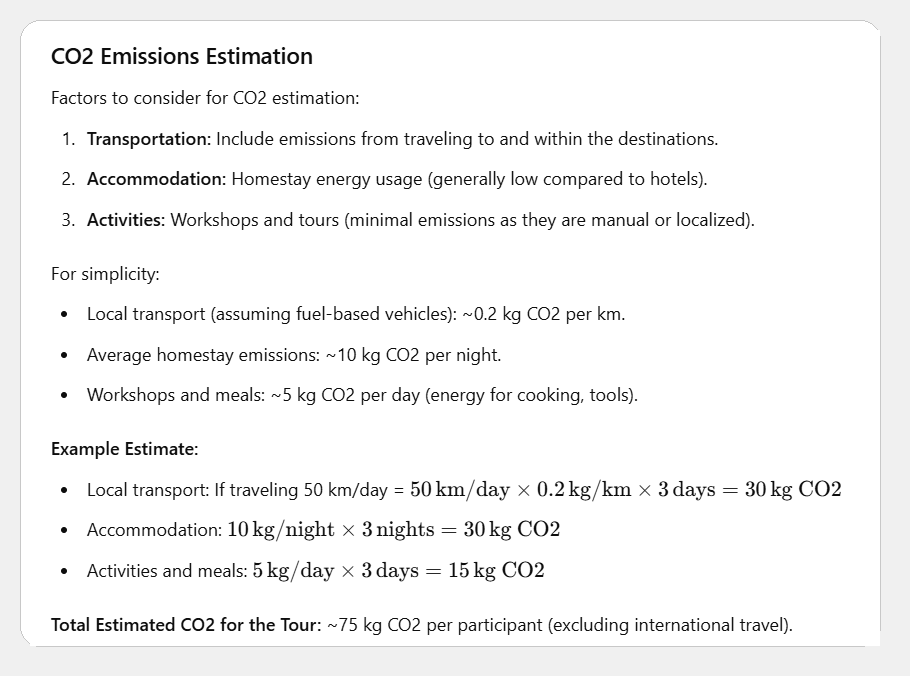
Source: Peter Fabricius and Guido van de Graaf
Implementing sustainable guidelines for certification with companies like Travel Life can be challenging for some companies. AI can be a valuable sustainability coach by providing tailored advice and solutions. You could fill in the form using Google AI Studio ‘looking over your shoulder’ to advise you or explain terminology you might not understand. Of course, you can also ask AI to provide you with tips on how to implement the guidelines.
Tools like Gemini Voice allow you to have one-on-one discussions with AI to explore ways to make your tourism organisation more sustainable and environmentally conscious.
You can also start sustainability yourself with the help of AI
Figure 39: Prompt to improve your sustainability with AI
Prompt to improve your sustainability with AI, creating a personalised survey, with questions you answer one by one, which will be turned your own sustainability report.

Source: Peter Fabricius and Guido van de Graaf
Figure 40: Response ChatGPT to start creating a sustainability report together
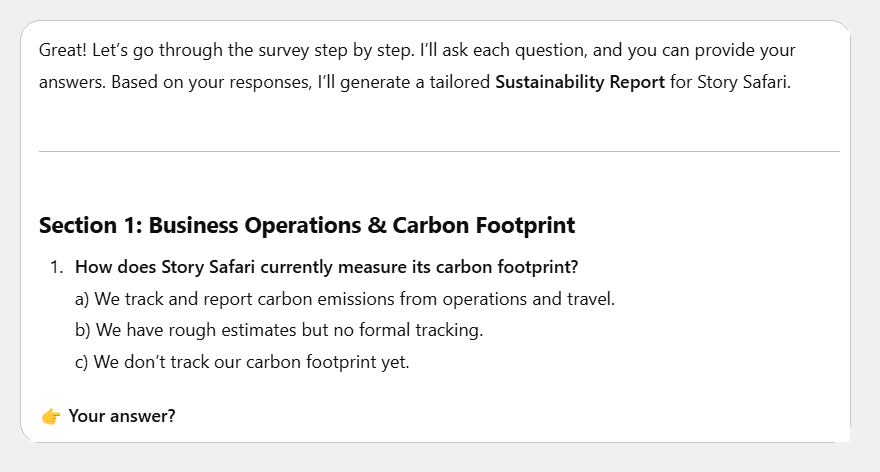
Source: Peter Fabricius and Guido van de Graaf
Tips:
- ChatGPT is surprisingly good at calculating the CO2 footprint of itineraries, giving companies and consumers insight into the impact of their travels.
- Create packing tips with AI for multi-day tours or trekking based on participants’ preferences to reduce waste.
- Let AI help you understand and complete sustainability certification programmes and get customised tips on how to apply their guidelines.
Conclusion
AI is set to change how we work, learn, communicate and deliver services in the tourism industry. The adjustment needed is relatively small, making sure data and knowledge are central and not hidden in silos, teams or individuals. Think, for example, of how a strategy is obvious in the owner’s mind but fragmented or misunderstood amongst others in the team.
Stay informed of the latest developments, and once you understand prompting, start thinking about how to apply AI in such a way in your business that it saves time and resources and creates a better service and experience. Start by creating a habit of asking AI to help you with everything you can think of, and not just help but actively ask, is there a way we can do this smarter? This way you use AI to amplify your journey in learning, working and creating together with AI.
Peter Fabricius / Bonfire and Guido van de Graaf / VTP Digital Marketing carried out this study on behalf of CBI.
Please review our market information disclaimer.
Search
Enter search terms to find market research
